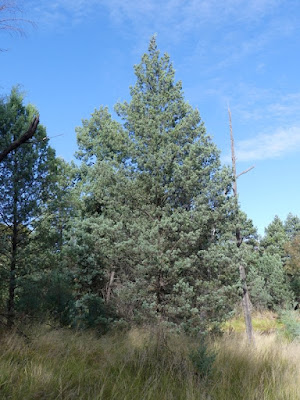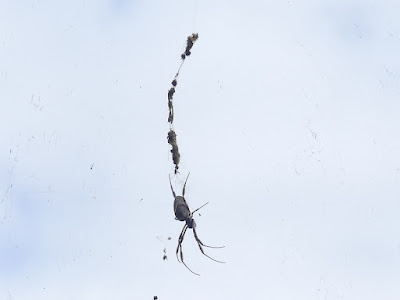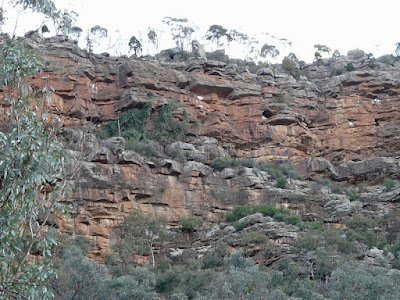North of Canberra, and a bit to the west, is an arc of four parks rising out of the plains of the western slopes of New South Wales. The western slopes comprise a broad belt of woodland (now mostly cleared for agriculture) falling gently to the west between the Great Dividing Range near the coast, and the vast inland semi-arid plains which stretch for thousands of kilometres to the Indian Ocean. The rich deep soils attracted graziers and farmers and the only reserves of any size are based on steep rugged ranges, unsuitable for agriculture, and the surrounding woodland fringes. The woodlands and grasslands of the plains in which the ranges stand are probably the most altered of any NSW habitat.
 |
From outside looking in. Weddin Mountains NP from the north-west;
this photo sets the scene for the isolated park. The highest point from this angle is
Eualdrie Peak which, at 733 metres asl, stands some 400 metres above the surrounding plain.
The range dominates the nearby regional centre of Grenfell, a former gold town.
|
 |
From inside looking out. The view from Peregrine Lookout on the eastern side, looking north-east.
Beyond the fringe of woodland at the base of the range are paddocks with scattered trees,
glowing yellow with canola crops.
|
And another from the park looking out, this to the north-west from Ben Hall's Cave.
 |
This rocky overhang is reached by an easy climb from the camp site. It is reputed that
the bushrangers used this as a lookout over the plain to watch for approaching police.
|
 |
Map of Weddin Mountains NP, from the excellent (but sadly out of print) National Parks Association's Guide to National Parks of Southern NSW (1996). You'll see it better if you click on it. Grenfell
is approximately 15k to the east, and the curved range is 19k long. The north and eastern sides
feature steep cliffs, while the western and southern sides slope more gently but are deeply
cut by creek gullies.
|
There are two campgrounds, one (now known as Ben Hall's Campground) is on the north-western edge marked Seaton's Camp on the map above, the other is at the end of Holy Camp Road in the north-eastern sector. This is a walk-in camp ground with no specified sites, at a spot where people go to picnic and begin a popular walk. Our preference is for Ben Hall's, which is very spacious with individual fairly well-spaced sites and lots of shady trees, especially spreading Kurrajongs.
Weddin Mountains, plus Conimbla, Nangar and Goobang National Parks to the north, are part of the larger Lachlan Fold Belt, a band of sandstones and shales laid down as the Hervey Terrestrial Basin under a shallow sea some 350 million years ago, and then lifted and twisted. Vast periods of erosion has left harder sections as ranges and outcrops above the plains. Until the end of the 19th century this was the land of the Wiradjuri people whose country stretched right across the plains. Their dispossession began in the early 1830s and was completed long before the end of the century. Folk heroes, the bushrangers Ben Hall, Johnnie Gilbert and Frank Gardiner, with associates, are closely associated with the range. A modest 8300 hectare Wildlife Refuge was gazetted in 1962, and declared a national park in 1971,
Enough background, let's go there! The sandstone ridges form a constant backdrop - all photos are from the Ben Hall's Cave area unless specified otherwise.
 |
I love the glimpses of the sandstone through the trees that can be encountered anywhere.
|
In some areas stubbornly erosion-resistant sandstone outcrops loom in the woodland floor.
 |
This is a well-known outcrop - and truly massive, metres tall - by the walking track from
the end of Holy Camp Road through an open-ended amphitheatre and up the range to
Peregrine and Eualdrie Lookouts.
|
The woodland in this amphitheatre is typical of much of the lower regions of the park, being dominated by Mugga Ironbark Eucalyptus sideroxylon and Black Cypress Pine Callitris endlicheri.
 |
Black Cypress Pine and the majestic Mugga Ironbark in the Holy Camp section of the park.
|
The Black Cypress can also form dense stands of forest in its own right.
 |
Black Cypress stand on the Ben Hall's Cave side; the dense stands of native grasses
(from a very recent trip there) are by no means typical over time, but a response to the current
wet La Niña phase of the cycle.
|
Also present is White Cypress Pine
Callitris glaucophylla, named for the dusty bloom on the foliage.
 |
White Cypress, with its termite-resistant timber, supports a forestry industry
in this part of the world, with significant state forests put aside for the purpose.
|
The entire park was burnt in the summer of 1974-5, and the northern half in January 2006. We were pleased to see quite vigorous cypress regeneration in the grassy areas near Seaton's Farm (by the Ben Hall's Cave campground). While cypress is fire-sensitive, some of this area was probably also cleared while it was part of the 60ha Seaton's Farm, founded by Jim Seaton in the 1930s and run by him and Bertha from when they married in 1948. Jim died in 1983 and Bertha sold the land to the parks service.
 |
Dwyer's Mallee Gum E. dwyeri, growing right alongside Ben Hall's Cave.
This small eucalypt, often in multi-stemmed mallee form, is most at home
on rocky hillsides on the western slopes.
|
 |
Kurrajongs Brachychiton populneus are among my favourite trees, and grow profusely
and healthily around the Ben Hall camp ground. Jim Seaton planted them all over his
property too, well knowing their value as stock food during drought when branches
are lopped, a practice still widely practised. (More about Kurrajongs here, though it
could probably do with updating some time.)
|
 |
During the warm afternoons we were happy to seek the shade of the
Kurrajongs alongside our camp.
|
There was obviously a splendid flowering there this summer, though it was rapidly drying out by the time we got there. There were vast areas of drying everlasting daisies and a few fresh flowers, including the ever-reliable bluebells.
 |
Wahlenbergia sp, perhaps stricta, growing in a profuse scramble in the Ben Hall campground.
|
One we were very pleased to have only just found before it dried out completely was represented by a couple of flowering spikes of Garland Lily Calostemma purpureum in a wet shady spot by a creek near our campsite.
 |
Garland Lilies are in the family Amaryllidaceae(ie with daffodils). It grows on flood plains
but apparently also on ridges, west from here into South Australia.
|
The Holy Camp side is noted for its orchids and, while we didn't see any this time, here are a couple from a previous (spring) visit. This far inland orchids aren't as prolific as they are nearer the coast, so all the more welcome.
 |
Sikh's Whiskers (or more prosaically but possibly more safely Boorman's Rusty Hoods
Pterostylis boormanii), a striking inland greenhood.
|
 |
Scented Sun Orchid Thelymitra megacalyptera.
|
For a park renowned for its birds, we didn't see as many as we expected on this occasion, and I don't seem to have many photos from previous trips either - something to rectify in the future! Ones we did see regularly included the local family of Apostlebirds Struthidea cinerea which paraded through camp, commenting loudly on everything and ducking for cover under the trailer when harassed by the local magpies.
 |
Apostlebirds are uniquely Australian (in a family shared only with White-winged Choughs),
mud-nest builders who are among the most developed cooperative breeders in the world.
|
 |
Common Bronzewing Pigeon Phaps chalcoptera high in a tree, showing off its iridescent
wing panels. A common bird but always good to see.
|
From camp we could see resident Wedge-tailed Eagles
Aquila audax soaring over and along the ridges, thrilling!
And a very poor photo of a very common bird, but it comes with a story.
 |
Willie Wagtail Rhipidura leucophrys disposing of an Australian Painted Lady.
The previous day while driving down a back street of Grenfell we'd been startled
(and perhaps a little shocked) when a young Collared Sparrowhawk fluttered briefly in
front of us, nearly over the bonnet, then plunged onto a luckless Willie Wagtail which may
also have been young, but clearly wasn't paying due care and attention. The incident and the
one with the butterfly reminded us of just what a food chain means -
one day a Willie is a victim, the next a predator. Should we have felt sorrier
for the dead Willie than the dead butterfly? Take your time...
|
Of course there are plenty of reptiles, active according to the weather, from very large to very small.
 |
Lace Monitor Varanus varius on an ironbark, near the Holy Camp carpark.
It has nearly finished shedding its skin - patches of old skin are left on the tail,
especially at the base.
|
 |
Young Bearded Dragon Pogona barbata among Jim Seaton's home-made fencing
(from salvaged scraps of wire) at Seaton's Farm.
|
 |
Another young dragon, this time a Jacky Lizard Amphibolurus muricatus, on
the track just below Ben Hall's Cave.
|
 |
And yet another youngster I think, though I've not identified this little skink yet.
To give you some idea of its size, it was on our solar blanket (a flexible sheet of
solar panels) featured in the photo of the camp site above, though that might not help much.
The weave on the cloth might be of more use.
|
And naturally, especially after such a wet summer, lots of smaller creatures (including many mosquitoes).
 |
Australian Painted Lady Vanessa kershawi, which were present in huge numbers.
Their preferred larval food plant is everlasting daisies, of which there was
a virtually infinite supply present.
|
 |
Heliotrope Moth Utetheisa pulchelloides. This is a striking, common little moth which even
amateurs like me can readily identify! Its main food plant now is probably Paterson's Curse
Echium plantagineum, an abundant weed which is much commoner than the native
members of the family Boraginaceae on which it evolved.
|
Another moth which we didn't see, though its larvae were all around us, was the Kurrajong Bag Moth Dichocrocis clytusalis whose 'bags' were adorning the Kurrajongs, especially younger trees.
 |
The caterpillars bind the leaves with silk to make the bags, then live in silken tubes
within them, emerging at night to feed on the leaves, leaving only skeletons. The couple
of bags I opened seemed empty apart from the frass (droppings), which makes
sense as the adults appear in autumn. We didn't see any of them, so most were
probably still pupating.
|
 |
Small Kurrajong covered in the bags. The tree is still healthy, and its
ordeal is pretty well over until next summer.
|
And of course, this wealth of small prey means plenty of predators.
 |
Wandering Ringtail Austrolestes leda, a widespread damselfly.
|
 |
I had a lot of trouble identifying this apparently distinctive dragonly until my friend
and dragonfly guru Harvey Perkins informed me that it's a young male
Scarlet Percher Diplacodes haematodes. The only dragonfly field guide doesn't
mention this minor detail - below is a photo I took of an adult male elsewhere
to show you why I was confused!
|
 |
Adult male Scarlet Percher, Central Australia - this is a very widespread species,
found throughout Australia and extending north to Timor, New Guinea and New Caledonia.
|
 |
Orbweb spider Araneus sp. This is a very large genus, with some 85 species
in Australia and 650-odd worldwide.
|
 |
Another orbweb, Nephila sp. I assume, though neither the light or my lack of
expertise are helping! If you click on the photo to enlarge it, you'll see the
tiny male cautiously approaching her from above to mate. His chances of surviving
the encounter are slim.
|
But, harking back to the sparrowhawk/Willie Wagtail/butterfly food chain, spiders turn out to be far from the top of this particular pyramid.
 |
A small spider wasp Fabriogenia sp., Family Pompilidae. She specialises in
spiders, especially big huntsmen, which she disables with a sting and stores in a mud cell previously
prepared (each one takes about day) and lays an egg on it. The grub which hatches grows by eating
the living spider. At least some species bite the spider's legs off to immoblise
it; this would be irrelevant if the spider were paralysed (as most are) but these wasps only temporarily
incapacitate their prey. By the time it recovers it is locked into the mud cell.
Unpleasant to contemplate I must agree.
|
The most dramatic event however took place mostly on the wooden picnic table provided with the campsite. For a long time a female wasp of a different spider-hunting family, Sphecidae, the thread-waisted wasps, dragged a paralysed orbweb spider around while she presumably searched for the mud cells she'd have previously constructed. She spent quite a bit of time looking in the gaps between the table-top planks but we never did see where she'd placed them - unfortunately she didn't seem to know either! It was fascinating to watch but a bit frustrating to not know how it turned out.
 |
Slender Mud-dauber Sceliphron laetum with paralysed orbweb spider,
destined to be wasp baby food.
|
And of course many animals, including Willie Wagtails, eat wasps...
The Weddin Mountains are an excellent place to spend a day or three; as we are able to move around again, please put them on your to-do list - you won't regret it.
NEXT POSTING THURSDAY 5 MAY
I
love to receive your comments and in future will be notifying you
personally by email when a new posting appears, if you'd like me to. All
current subscribers have been added to this mailing list and have
already been contacted. This will mean one email every three weeks at the current rate of posting. I promise never to use the list for any other purpose and will never share it.
Should you wish to be added to it, just send me an email at calochilus51@internode.on.net. You can ask to be removed from the list at any time,or could simply mark an email as Spam, so you won't see future ones.
Thank you!











































No comments:
Post a Comment